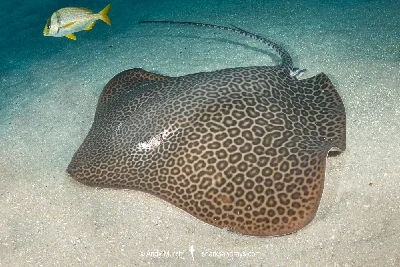Dasyatidae
The whiptail stingrays belong to the Dasyatidae family and are part of the Myliobatiformes order. They are distributed globally in tropical to temperate marine waters, with some species expanding into freshwater environments in Africa, Asia, and 🇦🇺 Australia. These rays possess flattened pectoral fin discs that vary in shape from oval to diamond-like. Their name derives from their elongated whip-like tails, which are significantly longer than the disc and lack dorsal and caudal fins. With the exception of the porcupine ray, all whiptail stingrays have venomous stingers near the base of their tail, serving as a defense mechanism. When stinging their prey, they forcefully whip their tails, causing the stinger to detach and remain lodged in the wound. The stingers of whiptail stingrays are sharp, pointed, and possess jagged edges. Their size ranges from 0.18 to 2.0 m or more, as observed in specimens such as the smalleye stingray and giant freshwater stingray.











